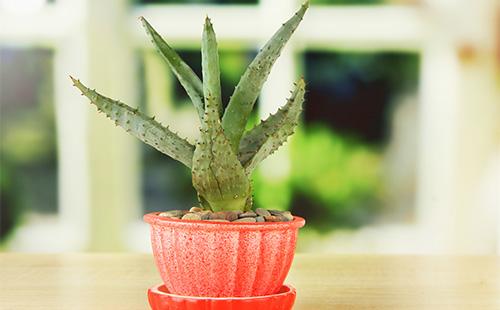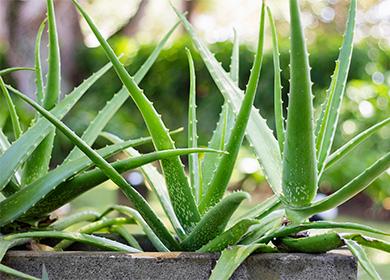The content of the article
Aloe is considered by many to be a plain, unattractive flower. But it may look completely different. A houseplant is undeservedly deprived of care, considering it completely unpretentious. This is partly true - it rarely dies, but with insufficient care it does not reveal its decorative qualities.
Appearance and Origin
Succulent plant of the subfamily asphodelaceae. It grows in nature mainly in the desert areas of Arabia and Africa. The genus has about 500 species. There are a variety of forms of plants - herbs, shrubs, tree forms. The leaves are always fleshy, often linearly lanceolate. They grow on a stem in a spiral shape, form dense rosettes.
Depending on the variety, the edges of the leaves are smooth, with cloves, spikes, cilia. The sizes are different - from 10 cm to 3 m in diameter. Some species in the natural environment grow by 15 m. Houses grow compact species of aloe.
In nature, it is a xerophyte, that is, it grows in arid areas. It has the ability to accumulate moisture in case of prolonged drought. The pulp of the leaf consists of small cells - inside and moisture accumulates. During a drought, the pores of the skin close to avoid strong evaporation.
Blooms rarely. Some species bloom only when they reach 20-30 years of age, others - already in the third to fifth year of life. A long peduncle appears from the center of the outlet. Its top is crowned with racemose inflorescence of bell-shaped drooping flowers. Inflorescences are red, white, yellow, orange. Flowering in the apartment is a rare case.
Indoor Varieties
Only three varieties are suitable for growing in an apartment. They are compact in size, unpretentious, highly decorative.
- Aloe vera. Pretty compact bush. The stems are short, fleshy. Leaves lanceolate, smoky green, form compact rosettes. The surface is covered with white spots, pinkish spikes grow along the edge of the leaf.
- Aloe is tree-like. People call it the agave. It grows fast, has longer stems. The xiphoid grayish-green leaves fold into rosettes.
- Aloe motley. Compact plant, not more than 30 cm in height. It is highly decorative. Based on the species, several improved breeding varieties were developed. The leaves are dark green, grow in a spiral, form dense basal rosettes. Against a dark background of leaves, dots and stripes of white color stand out.
Aloe care: what to consider for the grower
Despite the unpretentiousness, a houseplant needs full watering and transplants. How to care for aloe?
- Lighting. Aloe is believed to tolerate shading well. In fact, this is a very photophilous plant. In the shade it stretches, completely loses its decorative effect. Placed on the west or east window. It can be grown on the south side, but with mandatory shading. From the summer direct sun, ugly brown burns remain on the fleshy leaves. The room is often aired, in the summer the pot is taken out to the balcony or to the garden.
- Temperature. Aloe is neutral in temperature. In the warm period, from spring to mid-autumn, the average room temperature of 18-25 ° C is suitable for keeping. In winter, they arrange a rest period, lower the temperature to 14-17 ° C.
- Watering. The plant is susceptible to rot, so it is important to water aloe properly. In the summer, water abundantly, after the soil surface dries. The average frequency of watering is every three to four days. Water is poured along the edge of the pot - liquid is avoided on the leaves and in the root outlet. In winter, under the condition of cold maintenance, the intervals between irrigation are increased to two weeks.
- Humidity. It grows normally at any level of humidity. Spraying is an unnecessary and even dangerous procedure. Moisture in the axils of the leaves rot. Additional measures to increase humidity are not required.
- The soil. Suitable store soil for succulents. At home, the substrate is prepared from well-rotted deciduous land and coarse sand.
- Top dressing. They rarely feed - not more than once a month. Use balanced mineral fertilizers for succulents. During the rest period, feeding is not necessary.
- Transfer. If the root system has grown greatly, you need to transplant aloe into another pot. Young plants are transplanted annually, usually in autumn. The pot is chosen wide, spacious. Before planting, the soil is calcined in a pan, the pot is washed with a strong solution of potassium permanganate. Drainage is poured into the bottom. Old plants can not be transplanted - just replace the topsoil.
If you properly care for aloe after a transplant, the plant will quickly recover and move to growth. Aloe is temporarily removed from the sun, not watered heavily - only slightly moisten the soil. Keep at moderate temperature. After the appearance of signs of growth, they are returned to their original place.

Breeding methods
Aloe can be propagated in different ways - vegetatively or by seed. More commonly used vegetative propagation by lateral shoots, children, leaf.
- Side shoots. In spring or summer, the side shoots are separated from the base with a sharp knife. Slices sprinkled with activated charcoal, dried for two days in a dark, well-ventilated place. The shoots are slightly buried with the base in moist sand. Roots appear quickly - within a week. Rooted shoots are planted in separate pots, taken care of as adult plants.
- By sheet. Root leaves by analogy with the side shoots. The sheet is cut off at the base, treated with carbon powder, and dried. Planted in wet sand. Do not cover with a film! After the appearance of the shoots are transplanted into a pot.
- By the kids. A young shoot with an already developed root system appears near the mother bush. During an aloe transplant, it is carefully separated, planted in separate pots.
- Apical cuttings. Cut off the top with five to seven leaves. After processing with coal and drying, root it in moist sand or in a glass of water. This method is used if the root system has been affected, and aloe should be planted without root. Sometimes this is the only way to save the plant from root rot.
- The seeds. Growing from seeds is a long and laborious process.Sow the seeds in a light sand-peat mixture, spray from the spray gun, cover with a film until germination. Maintain a temperature not lower than 20 ° C. A little grown seedlings need to be planted. A year later, transshipment is carried out in full pots.
Growing difficulties
Loss of decorative aloe is usually associated with non-compliance with the rules of care. The table will help you analyze your mistakes and understand how to fix them.
Table - Improper aloe care and its effects
| External manifestations | What is the reason | How to help the plant |
|---|---|---|
| Leaf ends dry | - Lack of nutrients; - cramped pot | - Top dressing with complex mineral fertilizer; - transplant into a larger pot with soil replacement |
| Softening, yellowing of leaves | - excess moisture | - Regulation of watering |
| Drying, thinning leaves | - lack of light; - rare watering | - Moving to a bright place; - moderate but regular watering |
| The appearance of brown spots on leaf plates | - lack of moisture; - sunburn | - Shading from the sun; - systematic watering |
| The appearance of soft spots of dark green color | - Fungus; - stagnation of water in the axils of the leaves | - Watering only along the edge of the pot; - pruning of diseased aloe leaves, treatment with coal powder; - treatment of the plant with the antifungal drug Previkur |
| Leaf redness | - excess sun | - Moving the pot to a shaded place |
| Leaf fall | - Watering with cold water | - Settling water before irrigation, bringing its temperature to room temperature |
| Stem drying, growth retardation | - Damage to the root system | - Transplantation, inspection of the root system, removal of damage; - preventive treatment with fungicides; - trimming and rooting of the apex with severe damage to the root system |
Common pests and diseases
Pest attacks can be avoided only with regular preventive treatment of aloe with insecticides, observing the conditions of detention. The plant is affected by the mealybug, shieldsspider mite. The root system is sometimes damaged by nematodes. External signs of pest damage and methods of controlling them are described in the table.
Table - Aloe Pests
| Pest | External signs | Ways to fight |
|---|---|---|
| Shield | - Insects, similar to brown tubercles, visible visually; - yellowed leaves covered with shiny sticky coating | - Manual removal of insects; - washing leaves with soapy water; - spraying with the drug "Aktara" |
| Spider mite | - Yellowish specks on the leaves; - barely noticeable web | - Spraying with the drug "Aktara", "Aktellik"; - shelter aloe at night with a plastic bag |
| Mealybug | - Whitish waxy coating; - lumps similar to cotton wool | - Spraying with preparations "Fitoverm", "Biotlin"; - rubbing leaves with alcohol |
| Thrips | - Silver coating; - yellowed and fallen leaves | - Repeated treatment with any insecticide |
| Nematodes | - stunting; - noticeable swelling on the roots | - Trimming all damaged parts; - washing the roots in very warm (up to 50 ° C) water; - watering the soil with an insecticide |
The most common aloe diseases are root and dry rot. Root rot is caused by a lack of drainage, systematic waterlogging of the soil or the action of a fungus. It is characterized by decay of the root system. Treatment involves pruning softened roots, fungicide treatment and transplanting.
Dry rot is an insidious disease. The plant literally dries from the inside - it is not possible to save it. To prevent aloe disease, periodically sprayed with a fungicide solution.
Growing aloe at home will not be a problem, even for beginners. This is a very unpretentious, beautiful and healthy plant.With good care, it fully reveals decorativeness, can be used to make flower arrangements.

